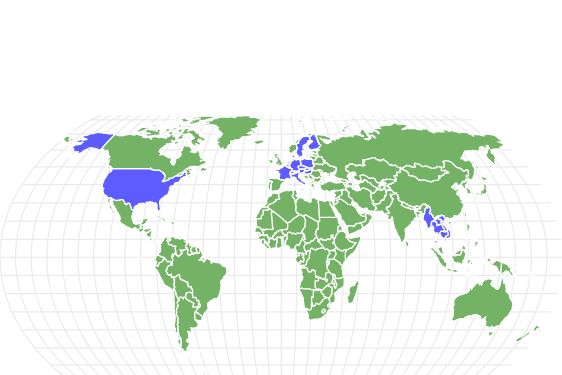Loach
Have sharp spines below their eyes
Advertisement
Loach Scientific Classification
Read our Complete Guide to Classification of Animals.
Loach Conservation Status
Loach Facts
- Prey
- Worms, other invertebrates
- Group Behavior
- School
- Fun Fact
- Have sharp spines below their eyes
- Biggest Threat
- overfishing, habitat destruction
- Most Distinctive Feature
- Whiskers
- Other Name(s)
- Clown loach, kuhli loach, hillstream loach
- Gestation Period
- 24 hours
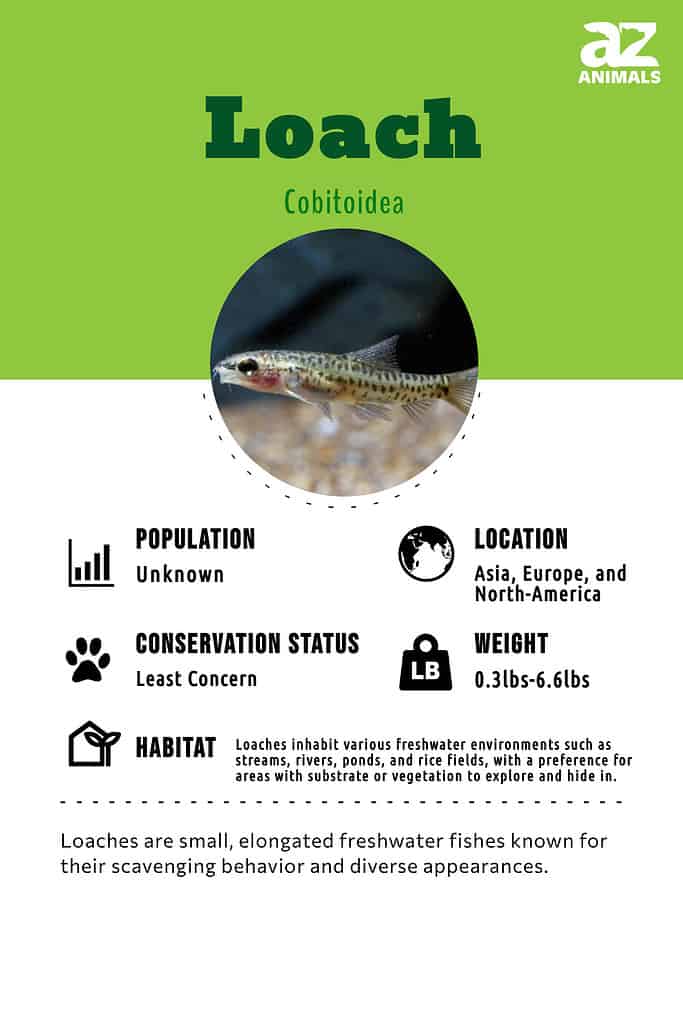
Many species of loach are popular in the aquarium trade.
The loach superfamily of fishes consists of over 1200 species, most of which are distributed in central and southern Asia. Some species are also found in Europe and Africa. They are known for their bottom-feeding and the barbels found close to their mouths. Loach fish prefer ponds and streams, either stagnant or fast-moving.
See all of our expert product reviews.
4 Incredible Loach Facts!
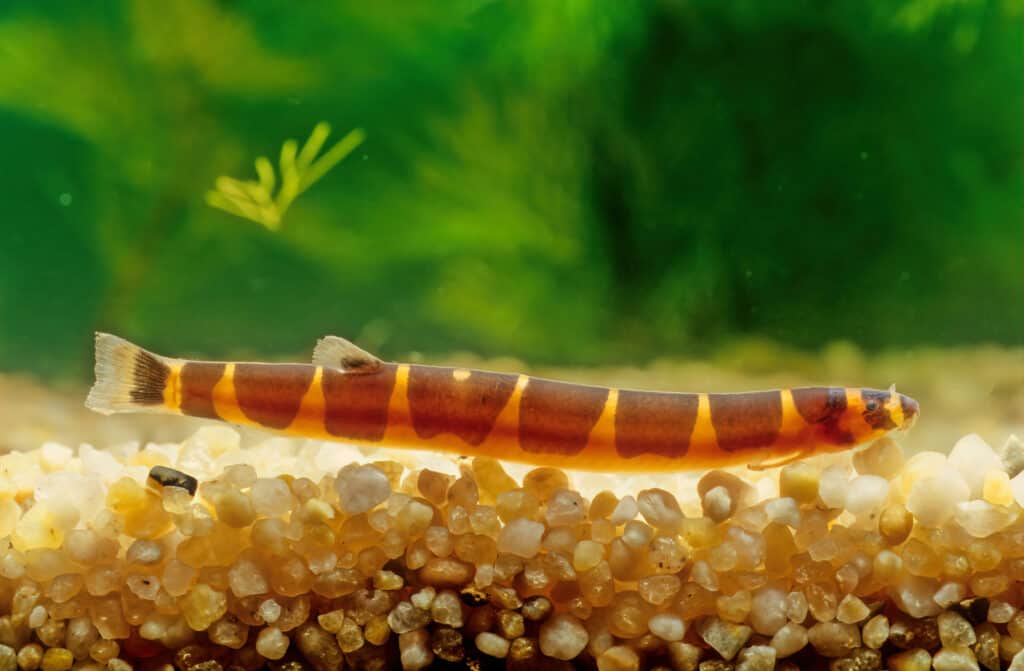
Kuhli loaches are part of the Cobitidae (loach) family.
©iStock.com/Miropa
- Loach fishes often have sharp barbs below their eyes for defensive purposes.
- There are over 1200 species in the superfamily Cobitoidea.
- Most species have barbels around their mouths, which they use to detect food.
- The yoyo loach is actually named after the black pattern on its side, which looks like it spells out “yoyo.”
Classification and Scientific Name
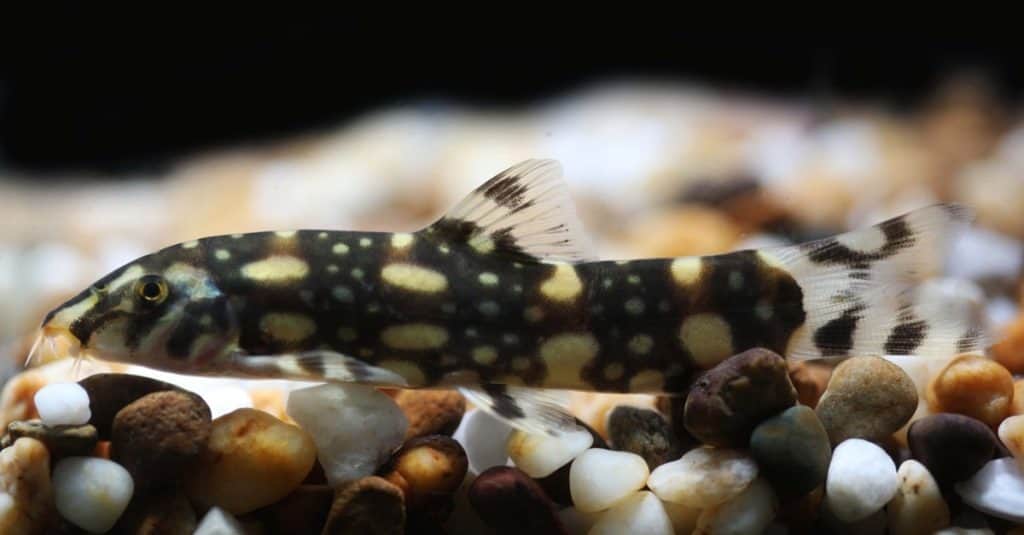
The term “Cobitoidea” originated from Aristotle’s time, long before the development of modern taxonomy, several centuries ago.
©Pavaphon Supanantananont/Shutterstock.com
The superfamily Cobitoidea includes an enormous amount of species. There are 9 families within the superfamily and about 107 genera. Cobitoidea comes from a term used by Aristotle, many centuries before modern taxonomy. Aristotle used the word cobitis to refer to any small fish that buries in the sediment.
Health and Entertainment for your Loach
See all of our expert product reviews.
Species
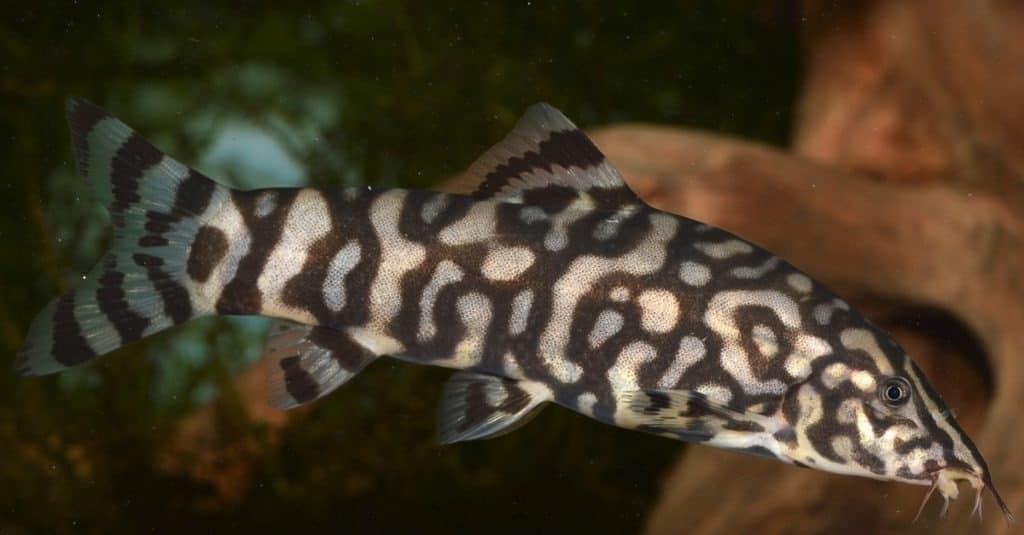
Cobitoidea, with its vast assemblage of more than 1200 species, stands as one of the largest superfamilies in the realm of fish.
©Guillermo Guerao Serra/Shutterstock.com
With over 1200 species in the superfamily, Cobitoidea is one of the largest in the fish world. A few popular species include:
- Clown Loach: These aquarium fish range from about 15-20cm in length and are largely diurnal, which is unusual for a species of loach. They are pale orange with dark black patches, giving them their “clown” namesake. Females are larger than males.
- Kuhli Loach: Another popular aquarium fish, Kuhli or “coolie” loaches are long and eel-like with dark bands covering their body. As adults, they are about 4 inches long. They can live to be up to 10 years old and are native to Southeast Asia.
- Yoyo Loach: Yoyo, or Pakistani loaches, are interestingly colored fish. They are white with thin black, curvy lines around their bodies that mark out “y” and “o” shapes, giving them their names. They also tend to bob up and down with the water levels, much like the popular “yoyo” children’s toy. These fish prefer slow-moving water.
- Hillstream or Butterfly Loach: Native to fast-moving bodies of freshwater in Asia, these fish is a taupe-colored species covered in intricate black markings. Hillstream loaches are also known as the Chinese Butterfly Loach. They have wide fins, which gives them their “butterfly” namesake, and are a docile species that prefer at least 3 tankmates of the same species.
- Java Loach: These fish are very similar to the kuhli loach, but do not possess the same black markings on their bodies. They are elongated and have a dark to pale brown color depending on their environment. These fish are 3in long when they are fully grown.
- Sumo Loach: Native to Myanmar, the colorful fish is a small, elongated species with bands of color along its sides. They have a patterned dorsal fin. The color of the fish can change, though it is not apparent what causes those changes.
- Golden Zebra Loach: Golden zebra loaches can be up to 5in long when fully grown. This fish is black and gold and grows a bold pattern as it ages. These fish sometimes nibble on softer plants.
- Rosy Loach: These are some of the smallest species, only reaching about 1.2in length. They are also a rare breed that does nicely in micro-aquariums.
Evolution and Origins
Loaches are a diverse group of small, generally elongated freshwater fishes belonging to the family Cobitidae. With over 200 known species, they are primarily native to central and southern Asia, while a few species can be found in Europe and one in northern Africa.
Their habitats range from rivers and streams to ponds and rice fields. Loaches exhibit a wide range of behaviors and adaptations, making them fascinating and popular additions to freshwater aquariums.
Furthermore, here’s some interesting information:
- Loaches are a fun addition to any tropical freshwater aquarium.
- They are peaceful scavengers that spend their time rooting for tidbits of food on the bottom.
- Many loach species prefer to be kept in schools.
- Some loach species may experience loneliness and deteriorate if kept alone.
Appearance
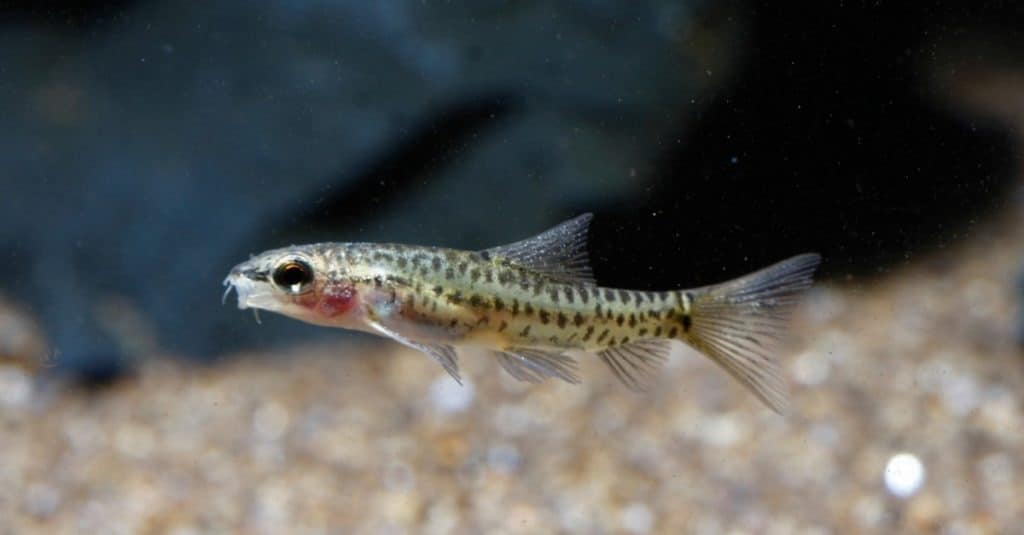
The physical appearance of loach fishes varies significantly from one species to another, exhibiting a wide range of variations.
©Pavaphon Supanantananont/Shutterstock.com
The loach fish’s appearance varies wildly depending on the species. Most of them are small and elongated, with barbels around their mouths and sharp spines beneath their eyes, which they use for defense. Their spines are small and flexible. These fish can grow anywhere from 1 to 8 in length.
These fish can be thin and small, like the rosy loach species. They can also be wide and large, like the popular butterfly loaches.
Some of them, like the clown, yoyo, and hillstream loach, have beautiful dark patterns on their scales.
Distribution, Population, and Habitat
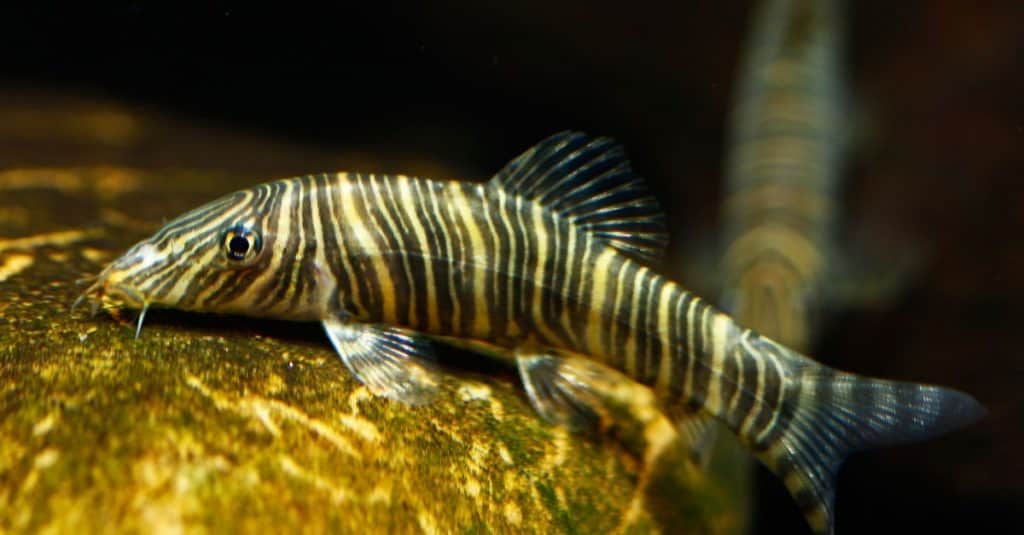
The majority of the known species are indigenous to Asia, specifically displaying a preference for freshwater streams in their natural habitats.
©Pavaphon Supanantananont/Shutterstock.com
Almost all of the existing species are native to Asia, where they prefer freshwater streams. Most species of these fish can be found high on the mountaintops, where the streams are swift and cold.
However, there are many lowland species of them as well. Some species, like the butterfly loach, prefer fast-moving streams. Other species like ponds and other low-oxygen bodies of water. Some have even lost their ability to see and live in the dark ponds and rivers of caves.
These fish do not form large schools, but they do appreciate the company of other fish of the same species. This is also true in captivity, as they will become hostile towards other fish species if they are the only loach in the tank.
One species of these fish is found in Africa, and three species have been found in Europe.
Predators and Prey
These fish prey on the various worms and larvae that fall close to the bottom of their habitats. They are omnivorous and bottom-feeders, which means they consume plant substrate as well. These fish in captivity should be fed a mixture of live food and fish flakes.
Humans consume these fish, specifically in East and Southeast Asia. Larger fish may also prey on the fish found in their environment.
Reproduction and Lifespan
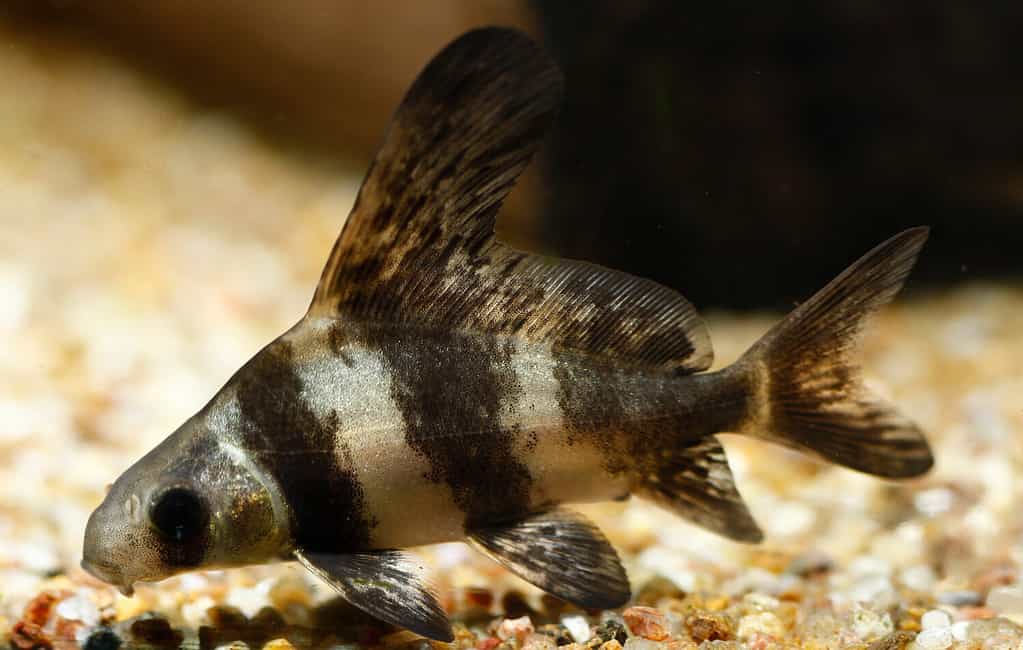
©Pavaphon Supanantananont/Shutterstock.com
Most loach species are extremely difficult to breed in captivity, and new loaches must be caught in the wild.
More of these fish in an environment will encourage breeding, as they are communal spawners. Females will lay their eggs on the undersides of leaves. Within 24 hours, the young will hatch from those eggs and swim away. Baby fish are called “fry.” Most eat soft plants or small invertebrates as their first meal.
Fishing and Cooking
The Japanese have been eating these fish for many centuries, and they are known as “dojo” in Japan. Most frequently they are seared or cooked in soup. They have soft meat and bones and are often served at the beginning of summer.
Population
With over 1200 species, these fish live in a wide variety of habitats and are at various risks of extinction. Most species are of Least Concern, but some are endangered. Overall, populations are declining slightly. This may be due to overfishing, or habitat loss.
View all 98 animals that start with LLoach FAQs (Frequently Asked Questions)
What is a loach?
Loaches are freshwater fish that feed on particulates and invertebrates present on the bottoms of streams and rivers. They’re usually elongated in shape and have barbels on the sides of their mouths.
Are loaches aggressive fish?
Loaches are not aggressive towards humans. When sharing a habitat with other fish, most loach species are docile when they have a small population of other loaches occupying the tank with them. When alone, loaches can become aggressive towards other fish species. This is why most fish shops require a purchase of at least 3 loaches at a time.
What do loaches eat?
Loaches are omnivores and bottom-feeders. They enjoy invertebrates like insect larvae and worms. In captivity, their live food diet can be supplemented with fish flakes.
What fish can live with loaches?
As long as they are provided with other loaches of the same species, loaches can coexist with many other different species of fish. Popular tankmates include barbs, tetras, and rasboras. Because loaches like to nibble, fish with long fins like guppies and angelfish should be avoided.
How much do loaches cost?
Loaches range in price depending on the species and the size. Smaller, younger loaches can be as cheap as $4, and larger fish (longer than 4″-6″) can cost upwards of $30.
In what type of habitat do Loaches live?
Loaches live in streams.
What is the lifespan of a Loach?
Loaches can live for 3 to 14 years.
What is another name for the Loach?
The Loach is also called the clown loach, kuhli loach, or hillstream loach.
What is an interesting fact about the Loach?
Loaches have sharp spines below their eyes.
How do Loaches have babies?
Loaches lay eggs.
Thank you for reading! Have some feedback for us? Contact the AZ Animals editorial team.
Sources
- Wikipedia, Available here: https://en.wikipedia.org/wiki/Loach
- Fishkeeping World, Available here: https://www.fishkeepingworld.com/yoyo-loach/
- Britannica, Available here: https://www.britannica.com/animal/loach
- Aquarium Nexus, Available here: https://www.aquariumnexus.com/hillstream-loach/
- Aquatic Arts, Available here: https://aquaticarts.com/products/rosy-loach-botia
- That Pet Place, Available here: https://www.thatpetplace.com/Schistura-balteata-sumo-loach-235390
- Nipponia, Available here: https://web-japan.org/nipponia/nipponia41/en/appetit/appetit01.html

